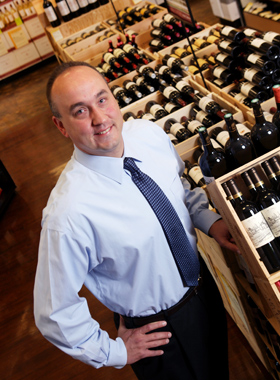Convergence Conquers Complexity for Total Wine & More
The data center is in transition. What was once a static infrastructure of applications chained to individual physical servers, networks and storage is now a pool of virtual, mobile resources that can be provisioned, scaled and moved across applications, data centers and locations at will.
Thanks to the proliferation of server virtualization coupled with the ubiquity of IP storage, organizations are turning to a growing class of technologies known as data center fabrics.
Like the interlocking strands of woven material, data center fabric creates an integrated, unified framework of virtualized servers, flexible storage and networking capabilities.
High density, on-demand provisioning and centralized management are key advantages of data center fabrics. They allow resources to be provisioned and scaled from a central pool quickly — without having to wait weeks for the various IT silos to do so. The result is not only superior business agility but more efficient utilization of existing data center resources.
Total Wine & More, an independent retailer of beverages and accessories, offers testament to the benefits of data center fabric. Since migrating to a Cisco Unified Computing System (UCS), the firm has gleaned better utilization of resources, reduced management requirements, lower overall total cost of ownership (TCO) and more.
Fast Growth
Headquartered in Potomac, Md., Total Wine & More is one of the largest independent retailers of wine, beer and accessories in the United States. The firm operates more than 85 superstores in 13 states, including Arizona, California, Delaware, Florida, Georgia, New Jersey, Maryland, Nevada, North and South Carolina, Texas, Virginia and Washington State.
A rapidly growing business with a unique business model, Total Wine & More has opened as many as a dozen new store locations in different states in a year. However, because alcohol-related laws tend to vary by state and even local jurisdiction, compliance can prove to be a challenge.
“In the beer and wine business, you have a three-tier supply chain system,” says Todd Slan, director of technology at Total Wine & More. “The middleman is different for every product and every state. And by law, you cannot cut out the middleman.”
Consider the result. Total Wine currently operates more than 85 stores. The firm stocks more than 15,000 products, each with as many as 40 to 50 different middlemen.
That means more than hundreds of thousands of unique supply chains — each with varying compliance rules — have to be managed simultaneously.
With such complex market and regulatory challenges, Total Wine found it necessary to develop its own customized, scalable enterprise resource planning (ERP) application.
The program is designed to manage the considerable growth in regulatory and supply chain information that comes with each new store location.
“We double in size every four-to-six years, so we have to continually commit to reinventing ourselves,” Slan says. “That’s why we need IT systems that are flexible and can scale easily and rapidly. It’s cost prohibitive for us to buy new systems every two years."
In addition, Total Wine & More’s low pricing and razor-thin margins require efficient utilization of IT resources. “The old-world standard of 40 to 50 percent server and storage utilization just doesn’t cut it anymore,” Slan adds. “We need to find ways to get that utilization much higher in order to keep costs, expenses and pricing under control.”
Two years ago, Total Wine & More found it was growing so fast that it had reached the limits of its partially virtualized data center.
“Our rack-based server infrastructure had maxed out our data center real estate,” Slan says. “We simply couldn’t expand on the platform we were using. We were forced to explore the possibility of building a larger data center somewhere else.”
In order to reclaim some existing data center real estate for expansion, the firm also began exploring the option of migrating to a converged data center infrastructure.

Photo: Paul S. Howell
“We double in size every four-to-six years, so we have to continually commit to reinventing ourselves,” Slan says. “That’s why we need IT systems that are flexible and can scale easily and rapidly. It’s cost prohibitive for us to buy new systems every two years."
“We considered several different solutions from a few different vendors,” Slan adds. “We eventually chose the Cisco UCS because of its ability to consolidate huge numbers of virtual servers in just a few blades.”
Total Wine also found similar benefits from NetApp network storage. “NetApp offered high-performance storage with fewer tray and rack units of space taken up in the data center,” Slan says.
The firm eventually settled on the NetApp FAS2240-2 unified storage array platform with serial attached SCSI (SAS) and SATA storage. The technology offers enhanced scalability, ease of management, increased efficiencies and reduced storage costs.
Total Wine and UCS
The most immediate benefit of Total Wine & More’s deployment of the Cisco UCS has been the beginning of a migration to a new point of sale (POS) system across all of its stores. The migration consists of a very large undertaking affecting the future of the entire organization. The project is scheduled for completion before the end of 2013.
“In order to make the transition, we had to put more than 50 new physical servers into our data center for development, test, QA [quality assurance] and production,” Slan says.
“We simply wouldn’t have had the rack real estate for such a deployment without Cisco’s UCS. Therefore, the new system would not be deployed as quickly and easily as it was.”
The tightly integrated nature of the Cisco solution allows Total Wine to pack many more virtual machines onto a single blade.
“We’ve been able to pack more than 100 servers on just four Cisco UCS blades,” Slan says. “Prior to the migration, we had those servers on much more bulky 4U rack-mount hardware that took up substantial rack real estate. The consolidation we achieved was significant.”
Server deployment for new business initiatives is also much easier than in the past. “It might have taken weeks to deploy a new server just a few years ago,” Slan adds. “With the UCS, deploying a new virtual server is incredibly quick and easy. Our development staff loves the ability to spin up new boxes instantly as they write and upgrade different parts of our ERP system.”
Even with deployment of the new POS system, there’s still plenty of room for future growth within the walls of Total Wine’s current data center. That’s fortunate because in the next two years, the company plans to again enhance its entire point-of-sale system with additional modules such as customer relationship management (CRM) and business intelligence (BI).
The firm also plans to harness the system to take advantage of data warehousing and mining in a big way.
“Our current system is much more decentralized. But with the new, centralized POS system, we’ll be able to get a lot more granular — mining information about buyers and sales,” Slan acknowledges. “By late 2013, we’ll be able to do indepth analysis on the more than 24 or 25 million customer transactions that we expect to have each year.”
By that time, Total Wine will be storing massive amounts of sales data by item, register, sale, transaction, customer and warehousing — slicing and dicing that data many different ways for competitive advantage.
“We’ll need a lot of computing and storage power to harness all that information effectively and drive accurate purchasing forecasts,” Slan says. “We’ll also have to save several years of that data for financial and auditing purposes. We’ll need to grow fast and we will, thanks to a unified computing system that is highly scalable and flexible.”
Major Cost Savings
Another benefit gleaned by Total Wine from the Cisco UCS has been reduced capital (CAPEX) and operating expense (OPEX). “The cost of a few new blades compared to 10 or 20 physical rack-mount servers is considerably less,” Slan notes. “And data center power, cooling and real estate costs per server are also a fraction of what they used to be.”
Deduplication capabilities, part of the NetApp unified storage system, are also saving the firm in the area of CAPEX. “We simply do not need as much storage capacity as we did before,” Slan adds.
Easier management has resulted in lower operating expenses as well. With the UCS’s central management console offering a single point for server and network management, deploying new resources to applications is much easier. And managing those resources is more centralized and less complex.
The simplified management allows Total Wine to continue growing without having to hire incremental IT staff.
Finally, deploying the Cisco UCS was relatively simple.
“The transition to the new infrastructure was very smooth,” Slan says. “Both the UCS and NetApp systems are now in production. All of our new projects and most of our legacy apps are running on them.”
Partners to Count On
Installing and deploying the new Cisco UCS infrastructure was made easier with assistance from the advanced technology professionals at Cisco and CDW. “With such rapid growth, we needed to shorten our learning curve and deliver the UCS to production as quickly as possible,” Slan says. “We turned to Cisco and CDW because of their experience and expertise with this infrastructure.”
“We have consistently worked with Todd Slan and his team to understand their business and how we can function to supplement their capabilities,” says Erin Stevens, executive account manager at CDW. “This project allowed us to leverage the knowledge of our pre-sales engineers, our valued partner relationships with Cisco and NetApp, and the skill of our delivery team.”
In all, the deployment of Cisco’s UCS has given Total Wine & More the agility, extended data center real estate and cost savings to continue to grow its business at the current rate or faster while implementing business initiatives quickly.
It all adds up to more ways to strengthen the company’s competitive advantage.








